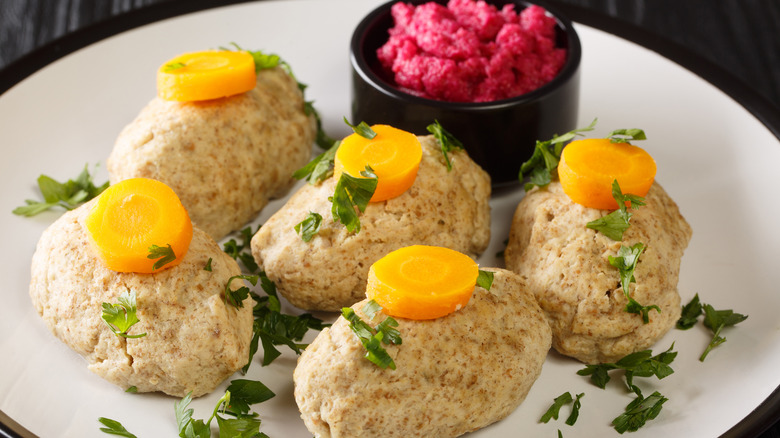Jewish Chef Explains How To Spice Up Your Traditional Passover Meal
Passover, as with many Jewish (or secular) holidays, centers around food. There is a sense of connection that comes from consuming the same foods as landsmen around the world, and a sense of commiseration with the ancestors who ate only unleavened bread while escaping slavery in Egypt. This year, Passover extends from April 5 to 13, beginning with a seder (or two), to usher in the official start of the holiday.
For one week (seven days if you live in Israel; eight if you don't), matzo replaces sourdough, pita, and ciabatta, aka chametz, or anything made with leavening agents. Before and during the meal, the seder host and guests will read from a Passover haggadah, which acts as a kind of guide for the evening. Jews eat from a communal seder plate, which includes a tasty mix of apples, cinnamon, wine, and nuts called charoset. The customary Passover menu of Ashkenazi Jews (who historically settled in Germany, France, and later Eastern Europe) includes matzoh ball soup, gefilte fish, roast chicken, beef brisket, potato kugel, and coconut macaroons.
Dara Lyubinsky, Chef and Founder of Nourish Culinary and weekly meal delivery service, Well Fed, spoke with Mashed about how to shake up a seder meal by looking to Sephardic Jews (who are associated with North Africa and the Iberian Peninsula). Lyubinsky said folks can spice things up by moving away from the "hyper-sweet flavor profile of Ashkenazi or Eastern European recipes, and lean more into the spiced and varied recipes of Sephardic tradition."
Adding different flavors to traditional foods
"It's fun to give the traditional meal a different flavor profile," Dara Lyubinsky told Mashed. "Sometimes I like to use things like preserved lemons and olives to braise the chicken rather than more traditional flavor profiles." The caterer has also previously described using Sephardic-inspired ingredients such as pomegranate molasses to flavor rainbow carrots and za'atar to spice up roasted chicken for holiday meals with her family (via Washington Jewish Week).
Lyubinsky says the essential dishes that anchor the seder meal are vegetable kugels and colorful salads with beets and carrots to add brightness. "We love to use the bounty of spring produce to make things like minted pea fritters and asparagus dishes, and serve something that feels really spring-y and happens to be naturally kosher for Passover," she says. To simplify the menu, Lyubinsky suggests buying gefilte fish from the supermarket and serving it with horseradish. Don't bother trying to make the fish patties from scratch, she says. "The juice just isn't worth the squeeze. We'd rather spend our time on the other parts of the meal." For dessert, Lyubinsky says flourless chocolate cake and macaroons are the only ways to go.

